By: John Landrigan [ka4rxp@gmail.com]
Plans continue to make certain that all is in readiness for my expeditionary cruise to Antarctica aboard the M/V Enderby in February 2018.
A cruise previously planned to Australia and New Zealand aboard the Holland American Line ‘”Noordam” occurred in late October. 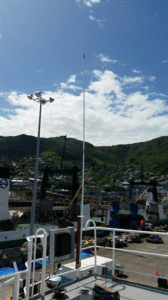 During that time I was able to visit with Rodney, the owner of Heritage Expeditions in Christchurch, New Zealand and Rowan Homes who owns Nautic Electronics.
During that time I was able to visit with Rodney, the owner of Heritage Expeditions in Christchurch, New Zealand and Rowan Homes who owns Nautic Electronics.
I gave Rowan the MFJ 998RT auto-tuner and he installed it inside of a Fiberglass Reinforced General Purpose enclosure. This and the Pacific Aerials High Frequency SSB Vertical were then mounted on a top deck railing aboard the Enderby.
(Left) Antenna and MFJ Auto-Tuner on top deck of M/V Enderby.
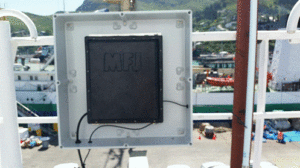
MFJ 998RT inside reinforced fiberglass enclosure (Right)
Another project was to be assured the primary radio set up – the Yaesu FT 897 and SPE 1.3KW amplifier were communicating happily with each other and the MFJ 998RT auto-tuner. This necessitated a ‘road trip’ to Starkville, Mississippi, home of MFJ where Martin Jue, Richard Stubbs, Ben, Mike and others let me set up a temporary station using a vertical antenna and testing everything out. All worked well.
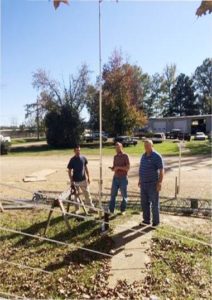
MFJ employees setting up temporary vertical so functional testing of the Yaesu 897, SPE 1.3KW amplifier and MFJ 998RT auto-tuner could be verified. (see pic to the Right)
Bolted onto an aluminum panel with padding underneath are the Yaesu FT-897 and SPE 1.3KW amplier. The amplifier can fly as in-cabin, carry on luggage due to its compact size and 22 pounds weight. The SCS Pactor Modem and West Mountain Radio RigBlaster Blue sit on top of the white Velcro mounting patches.
My visit with Rodney was most enjoyable and informative. This voyage is one that I feel especially fortunate to be going on. I’ll provide more details via the radio email Winlink program during the trip.
If propagation is more favorable in February than it was in October, I should be able to make a large number of contacts especially during Antarctica Activity Week, February 17 to 25, 2018.
As a back up, I will be using an Icom 7100. A problem shared by both the FT 897 and the IC 7100 is a lack of sockets to plug stuff into. Common to both radios is the need to have an SCS PACTOR Modem as part of the complement, and, to have minimal to none cable switching going on.
(Below:) Equipments: Yaesu FT-897 and SPE 1.3KW amplifier
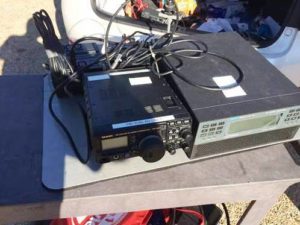 The FT 897 problem was resolved with a bhi CAT-MATE Electronic “Y” Splitter and a quick jumper move at J102 on the ACC 1/8 inch socket for ALC and PTT control to the SPE amplifier.
The FT 897 problem was resolved with a bhi CAT-MATE Electronic “Y” Splitter and a quick jumper move at J102 on the ACC 1/8 inch socket for ALC and PTT control to the SPE amplifier.
The Icom 7100 requires the use of the ACC conversion cable (OPC-599). ACC1 on the “Y” cable accepts a 9090 cable from Farallon Electronics to the SCS PACTOR Modem. The ACC2 socket will take the PNP-7D1 cable to the MFJ Ameritron ARB-704 amplifier-to-transceiver interface. The ARB-704 will output ALC and PTT to the SPE amplifier.
Of course another road trip to Starkville will be necessary to make sure all this works.
Next on the list is an after Christmas shopping trip to the Mall of America in Minneapolis, Minnesota for warm weather gear as per the suggestions of Heritage Expeditions and several other ham friends.
All I want for Christmas is an SFI above 100 for the month of February. I won’t be too dismayed if there is a good to spectacular auroral display sometime before we get to midnight sun conditions.
TNX and credit: John Landrigan KA4RXP
What else to say? John, congrats for the excellent job. You and your friends are doing really great.
All seems to be well planned, and your Antarctic adventure, I’m sure, will give you lots of satisfactions; we’ll follow you every day.
 Expedition vessel M/V Ivan Papanin, after completing cargo operations at Bharati Station (WAP IND-Ø4) Larsemann Hills (69° 24’ 24.4” South, 76° 11’ 42.9” East) started her onward journey at 23:35 Hrs local time (18:35 UTC) on Monday, 05 February 2018 heading to the second Indian Station Matiri (WAP IND-Ø3) at Schirmacher Oasis (70° 46’ 00” South, 11° 43’ 50.8” East).
Expedition vessel M/V Ivan Papanin, after completing cargo operations at Bharati Station (WAP IND-Ø4) Larsemann Hills (69° 24’ 24.4” South, 76° 11’ 42.9” East) started her onward journey at 23:35 Hrs local time (18:35 UTC) on Monday, 05 February 2018 heading to the second Indian Station Matiri (WAP IND-Ø3) at Schirmacher Oasis (70° 46’ 00” South, 11° 43’ 50.8” East).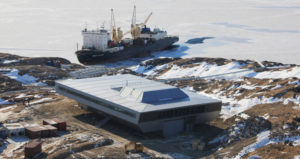 station (see stock pic aside)
station (see stock pic aside)
 For those who did not know, in 1975 the first Italian adventure in Antarctica did start by a private expedition carried out by a Milanese entrepreneur: Renato Cepparo.
For those who did not know, in 1975 the first Italian adventure in Antarctica did start by a private expedition carried out by a Milanese entrepreneur: Renato Cepparo.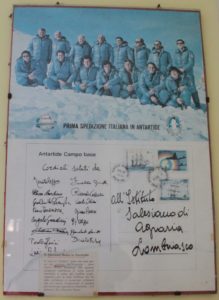 Now, going out the gymnasium of the Salesian Institute of Lombriasco (Turin, Italy) I did find, hanging on a wall, a postcard signed by the members of the Cepparo expedition, sent on December 25, 1975 from Antarctica to the Salesian Institute of Agriculture of Lombriasco; besides being a precious rarity, it’s a real scoop!
Now, going out the gymnasium of the Salesian Institute of Lombriasco (Turin, Italy) I did find, hanging on a wall, a postcard signed by the members of the Cepparo expedition, sent on December 25, 1975 from Antarctica to the Salesian Institute of Agriculture of Lombriasco; besides being a precious rarity, it’s a real scoop!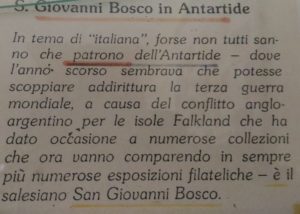
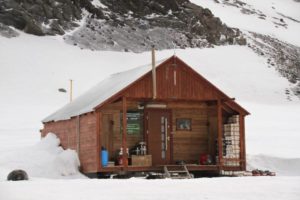 Lions Rump Refuge (62° 06′ South, 58° 05′ West) is a strip of ice-free beaches, moraines and rocks, located on the King George Bay. It is separated from Arctowski Station (WAP POL-Ø1) by a glacier and the waters of the Bransfield Strait. The majority of this area is protected as ASPA 151 (Antarctic Special Protected Area), which in general can be called the equivalent of our nature reserve. The name of the refuge comes from the rock,Lions Rump rlocated in the ASPA.
Lions Rump Refuge (62° 06′ South, 58° 05′ West) is a strip of ice-free beaches, moraines and rocks, located on the King George Bay. It is separated from Arctowski Station (WAP POL-Ø1) by a glacier and the waters of the Bransfield Strait. The majority of this area is protected as ASPA 151 (Antarctic Special Protected Area), which in general can be called the equivalent of our nature reserve. The name of the refuge comes from the rock,Lions Rump rlocated in the ASPA.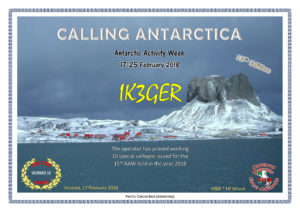 All WAP (Worldwide Antarctic Program) stations have a special WAP reference number that will be given during the QSO.
All WAP (Worldwide Antarctic Program) stations have a special WAP reference number that will be given during the QSO. It’s now time to book the 15th AAW, getting your special call, your WAP reference number and jump into the unique International Ham event to promote Antarctica … join in and enjoy it!
It’s now time to book the 15th AAW, getting your special call, your WAP reference number and jump into the unique International Ham event to promote Antarctica … join in and enjoy it! February 25nd. Someone may ask the reason of why this edition is two days longer than the past years; well, several participants did ask the possibility to have 2 weekends instead of 1 … so this year will be a test, if 2 more days are felt too long, next edition will return back to 7 days activity.
February 25nd. Someone may ask the reason of why this edition is two days longer than the past years; well, several participants did ask the possibility to have 2 weekends instead of 1 … so this year will be a test, if 2 more days are felt too long, next edition will return back to 7 days activity.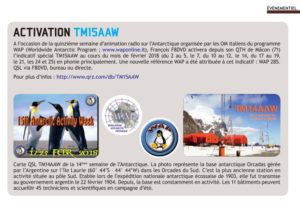 the January issue of REF bulletin.
the January issue of REF bulletin. Pedro LU1JHF, informs WAP that Juan C. Benavente (LU8DBS) is actually active from Base T.te Benjamin Matienzo 64° 58’ 34” South, 60° 04’ 05” West, as LU1ZAB. Check daily on 7,118 MHz. from 23:00 (UTC) and sometimes from 02: 00 (UTC), in SSB. Juan should be there till February 2018
Pedro LU1JHF, informs WAP that Juan C. Benavente (LU8DBS) is actually active from Base T.te Benjamin Matienzo 64° 58’ 34” South, 60° 04’ 05” West, as LU1ZAB. Check daily on 7,118 MHz. from 23:00 (UTC) and sometimes from 02: 00 (UTC), in SSB. Juan should be there till February 2018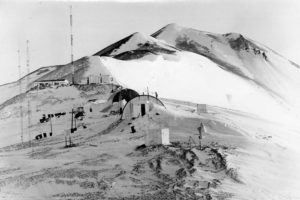
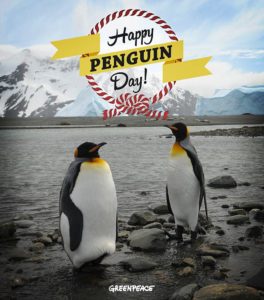 20 January is a day dedicated to the world of penguins: did you know that they are aquatic animals and that their survival depends on the health of the oceans? Protecting their ecosystem is the only way to help them.
20 January is a day dedicated to the world of penguins: did you know that they are aquatic animals and that their survival depends on the health of the oceans? Protecting their ecosystem is the only way to help them.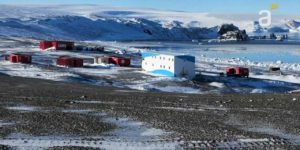 with about 5 tons of frozen food and 226,000 liters of Antarctic gas oil.
with about 5 tons of frozen food and 226,000 liters of Antarctic gas oil. Russian Antarctic Bases Award (RABA) managed by Russian Robinson Club is given for QSO/SWL with radio stations situated on the territory of the ex USSR and Russian Antarctic Bases. Certificates are issued in three different classes with Plaque – Honour Roll and the last born “Plaque.of Excellence”.
Russian Antarctic Bases Award (RABA) managed by Russian Robinson Club is given for QSO/SWL with radio stations situated on the territory of the ex USSR and Russian Antarctic Bases. Certificates are issued in three different classes with Plaque – Honour Roll and the last born “Plaque.of Excellence”. The station will be set on Inexpressible Island in Terra Nova Bay in the Ross Sea. After it is built, the year-round base will be used to investigate the land, sea, atmosphere, and glaciers in the Antarctic. Chinese icebreaker ‘Xuelong is bound for Antarctica with construction materials in tow to build the country’s fifth scientific research station on the continent.
The station will be set on Inexpressible Island in Terra Nova Bay in the Ross Sea. After it is built, the year-round base will be used to investigate the land, sea, atmosphere, and glaciers in the Antarctic. Chinese icebreaker ‘Xuelong is bound for Antarctica with construction materials in tow to build the country’s fifth scientific research station on the continent. Despite its frigid solitude, at several sites in the Antarctic nations from around the world have joined forces in the name of research: the Argentinian Carlini Station ( ex- Estacion Cientifica T.te Jubany) WAP ARG-20 on King George Island, one of the South Shetland Islands, is a prime example:Different nations, all under one roof,
Despite its frigid solitude, at several sites in the Antarctic nations from around the world have joined forces in the name of research: the Argentinian Carlini Station ( ex- Estacion Cientifica T.te Jubany) WAP ARG-20 on King George Island, one of the South Shetland Islands, is a prime example:Different nations, all under one roof,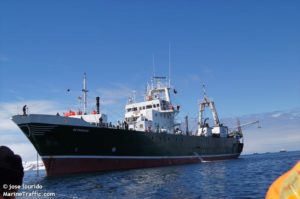 DAP, the Chilean company that owns and operates the M/V Betanzos and the helicopters with a cost of almost 1/2 million U.S. dollars.
DAP, the Chilean company that owns and operates the M/V Betanzos and the helicopters with a cost of almost 1/2 million U.S. dollars.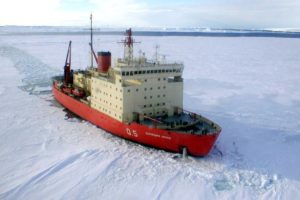 The Argentinean Antarctic Summer Campaign 2017/2018, formally started on last December 18, 2017, when the ship “Estrecho de San Carlos” and the naval transport “Canal de Beagle” sailed from the port of Buenos Aires.
The Argentinean Antarctic Summer Campaign 2017/2018, formally started on last December 18, 2017, when the ship “Estrecho de San Carlos” and the naval transport “Canal de Beagle” sailed from the port of Buenos Aires. Kerry Peters was an elementary school teacher when he was offered retirement . He didn’t really had any of those “What will I do with myself now?” anxieties. He took retirement when it was offered, because he was already looking forward to what came next: exploring the polar regions.
Kerry Peters was an elementary school teacher when he was offered retirement . He didn’t really had any of those “What will I do with myself now?” anxieties. He took retirement when it was offered, because he was already looking forward to what came next: exploring the polar regions.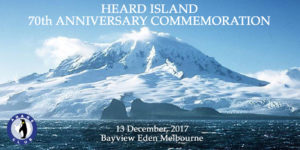 Lee Moyle VK3GK is operating VI7ØHI, a Special Callsign issued to Commemorate the first ANARE Expedition to Heard Island in December 1947.
Lee Moyle VK3GK is operating VI7ØHI, a Special Callsign issued to Commemorate the first ANARE Expedition to Heard Island in December 1947. dog run, and a large tractor. These men carried out meteorological, geophysical, upper atmosphere, and biological research, a program that continued for 7 years until the base was abandoned. Since 1969, ANARE has visited Heard Island every few years, mostly to check up on the ruins of the original encampment.
dog run, and a large tractor. These men carried out meteorological, geophysical, upper atmosphere, and biological research, a program that continued for 7 years until the base was abandoned. Since 1969, ANARE has visited Heard Island every few years, mostly to check up on the ruins of the original encampment.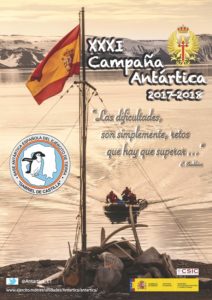 230 people will participate to the XXXI Spanish Antarctic Campaign, carry out 16 research projects, two of them aboard the Hespérides Oceanographic Research Ship, which will also support five international projects of Germany , Belgium, Colombia and Portugal. In addition, in this campaign will also be released a warehouse module at the Gabriel de Castilla Antarctic Base, (WAP ESP-Ø2) managed by the Spanish Army.
230 people will participate to the XXXI Spanish Antarctic Campaign, carry out 16 research projects, two of them aboard the Hespérides Oceanographic Research Ship, which will also support five international projects of Germany , Belgium, Colombia and Portugal. In addition, in this campaign will also be released a warehouse module at the Gabriel de Castilla Antarctic Base, (WAP ESP-Ø2) managed by the Spanish Army.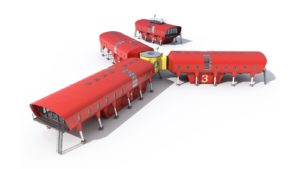
 The new buildings, set in the shape of a clover or tripod, has 2,000 square meters of living space, 600 meters of laboratories, 1,500 square meters of storage, and capacity for 52 people per module.
The new buildings, set in the shape of a clover or tripod, has 2,000 square meters of living space, 600 meters of laboratories, 1,500 square meters of storage, and capacity for 52 people per module. To the thousands of Antarctic friends & followers, to the Teams working actually in Antarctic Stations and remote camps, to those embarked on Supply and Support Ships boarding the Icy Continent, to any individual personnel involved in Antarctica away from home and family.
To the thousands of Antarctic friends & followers, to the Teams working actually in Antarctic Stations and remote camps, to those embarked on Supply and Support Ships boarding the Icy Continent, to any individual personnel involved in Antarctica away from home and family.
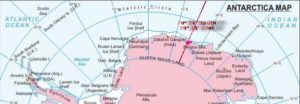 Pakistan is maintaining a summer research station (Jinnah Antarctic Station) and one weather observatory in the vicinity of Sør Rondane Mountains. Pakistan is also planning to build a full fledged permanent base at Antarctica which will enable the program to start operations in Antarctica throughout the year.
Pakistan is maintaining a summer research station (Jinnah Antarctic Station) and one weather observatory in the vicinity of Sør Rondane Mountains. Pakistan is also planning to build a full fledged permanent base at Antarctica which will enable the program to start operations in Antarctica throughout the year.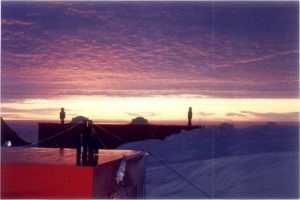 research station operated by the Pakistan Antarctic Program; facilities were quickly established in the region. The station houses an unmanned automatic Weather Station, from which data are transmitted to Pakistan via Argos Satellite System In 2001, the Badr-B was connected to the Weather Station after it was launched by SUPARCO. In 2006, Pakistan established the National Institute of Oceanography’s Polar Research Cell (PRC).
research station operated by the Pakistan Antarctic Program; facilities were quickly established in the region. The station houses an unmanned automatic Weather Station, from which data are transmitted to Pakistan via Argos Satellite System In 2001, the Badr-B was connected to the Weather Station after it was launched by SUPARCO. In 2006, Pakistan established the National Institute of Oceanography’s Polar Research Cell (PRC).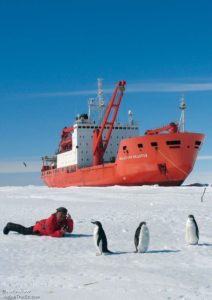 Oceanographic research ship Akademik Fedorov (or Fyodorov ) is one of the Russian icebreaker ships, a diesel-electric research vessel (RV) and the flagship of the Russian scientific polar research fleet. The ship was built for the USSR (Soviet Union) and started operations in October 1987.
Oceanographic research ship Akademik Fedorov (or Fyodorov ) is one of the Russian icebreaker ships, a diesel-electric research vessel (RV) and the flagship of the Russian scientific polar research fleet. The ship was built for the USSR (Soviet Union) and started operations in October 1987.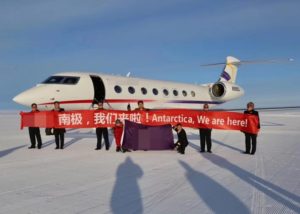 Media caption heading to Antarctica by plane is the exception, not the rule. According to Chinese media, the country’s first commercial flight to Antarctica brought 22 lucky tourists to the exotic destination this weekend.
Media caption heading to Antarctica by plane is the exception, not the rule. According to Chinese media, the country’s first commercial flight to Antarctica brought 22 lucky tourists to the exotic destination this weekend.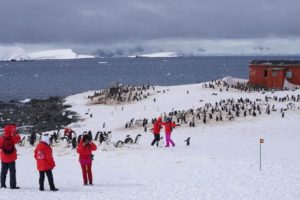 hours to the pole, where the flight landed on a 2.5-km (1.5-mile) runway carved into the ice.
hours to the pole, where the flight landed on a 2.5-km (1.5-mile) runway carved into the ice. To the Antarctic friends, followers & Chasers
To the Antarctic friends, followers & Chasers

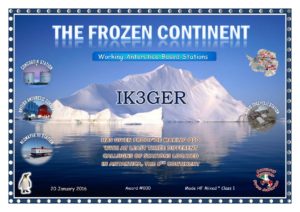 From 2013 the “The Frozen Continent” Certificate is released by IK3GER and it’s free. It will be sent via email (PDF or JPEG format file) to the Hams who request it to the Manager IK3GER:
From 2013 the “The Frozen Continent” Certificate is released by IK3GER and it’s free. It will be sent via email (PDF or JPEG format file) to the Hams who request it to the Manager IK3GER:  operators operating portable in Italy. QSL from San Marino (T7), SMOM (1A0) and the Vatican (HV) are not accepted for this award
operators operating portable in Italy. QSL from San Marino (T7), SMOM (1A0) and the Vatican (HV) are not accepted for this award From the unknown to scientific research, see how the mystery of Antarctic exploration has unfolded throughout the years.
From the unknown to scientific research, see how the mystery of Antarctic exploration has unfolded throughout the years.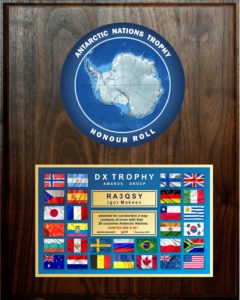
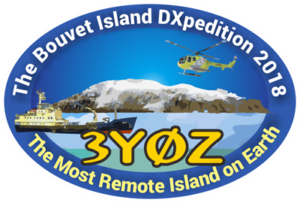 The plan is to sail for Bouvet Island on January 13, 2018. Depending on the winds and sea conditions, it will be a 10 to 12-day sail to Bouvet. The earliest arrival date will be January 23. Time to get ashore is weather dependent. As soon as the wind, sea conditions and visibility allow, the Team will begin helicopter flights to the island. Their Amateur radio license, also originally issued in 2007 with the call sign of 3YØZ, has been renewed and will be used during the DXpedition.
The plan is to sail for Bouvet Island on January 13, 2018. Depending on the winds and sea conditions, it will be a 10 to 12-day sail to Bouvet. The earliest arrival date will be January 23. Time to get ashore is weather dependent. As soon as the wind, sea conditions and visibility allow, the Team will begin helicopter flights to the island. Their Amateur radio license, also originally issued in 2007 with the call sign of 3YØZ, has been renewed and will be used during the DXpedition.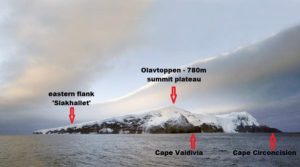 Bouvet lies at 54° 25’ South and Ø3° 22’ East. It’s the product of a volcanic eruption that last occurred in 4,000 B.C. Bouvet is 97% ice covered, and with surrounding rocks and small islands, has an area of 19 square miles, with 18.4 miles of coastline. Its location, ice, rock cliffs, high seas, harsh climate and surrounding pack ice and icebergs isolate it from human presence. Jean-Baptiste Charles Bouvet de Lozier first saw the island in 1739.
Bouvet lies at 54° 25’ South and Ø3° 22’ East. It’s the product of a volcanic eruption that last occurred in 4,000 B.C. Bouvet is 97% ice covered, and with surrounding rocks and small islands, has an area of 19 square miles, with 18.4 miles of coastline. Its location, ice, rock cliffs, high seas, harsh climate and surrounding pack ice and icebergs isolate it from human presence. Jean-Baptiste Charles Bouvet de Lozier first saw the island in 1739. 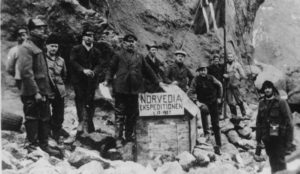 The island was not seen again until 1808. There was a disputed landing by Benjamin Morrell. But, the first documented landing was by the Norvegia expedition in 1927, which named the island Bouvetoya, and claimed it for Norway.
The island was not seen again until 1808. There was a disputed landing by Benjamin Morrell. But, the first documented landing was by the Norvegia expedition in 1927, which named the island Bouvetoya, and claimed it for Norway.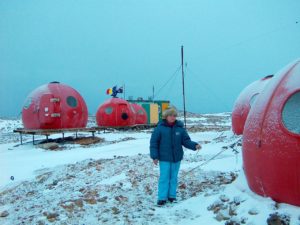 Law-Racoviță Station is placed in a rocky area about 3 kilometers from the Ingrid Christensen coast in Princess Elizabeth Land, in the Larsemann Hills of East Antarctica, at the coordinates 69°23’18.61″ South, 76°22’46.2″ East
Law-Racoviță Station is placed in a rocky area about 3 kilometers from the Ingrid Christensen coast in Princess Elizabeth Land, in the Larsemann Hills of East Antarctica, at the coordinates 69°23’18.61″ South, 76°22’46.2″ East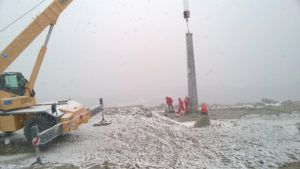 The wind is again the protagonist in Antarctica. Not only as a driving force for the climate “, but also as a driving force of the first wind farm built in the Italian Mario Zucchelli Station (WAP ITA-Ø1) at Baia Terra Nova, which since 1985 houses the scientific laboratory of PNRA, the National Program of Research in Antarctica, financed from the MIUR (Ministry of Education, University and Research) with the logistic implementation of ENEA (National Agency for New Technologies, Energy and Sustainable Economic Development) and the scientific coordination of the CNR (National Research Council).
The wind is again the protagonist in Antarctica. Not only as a driving force for the climate “, but also as a driving force of the first wind farm built in the Italian Mario Zucchelli Station (WAP ITA-Ø1) at Baia Terra Nova, which since 1985 houses the scientific laboratory of PNRA, the National Program of Research in Antarctica, financed from the MIUR (Ministry of Education, University and Research) with the logistic implementation of ENEA (National Agency for New Technologies, Energy and Sustainable Economic Development) and the scientific coordination of the CNR (National Research Council).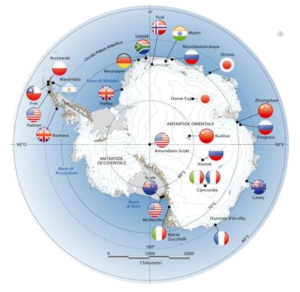 1st December 2017 – Antarctica Day falls on the anniversary of the adoption of the Antarctic Treaty, which took place on 1 December 1959.
1st December 2017 – Antarctica Day falls on the anniversary of the adoption of the Antarctic Treaty, which took place on 1 December 1959.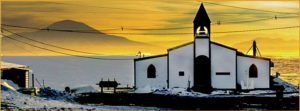 The Chapel of the Snows, a non-denominational place of worship at NSF’s McMurdo Station, Antarctica, overlooks McMurdo Sound and the Royal Society mountain range.
The Chapel of the Snows, a non-denominational place of worship at NSF’s McMurdo Station, Antarctica, overlooks McMurdo Sound and the Royal Society mountain range.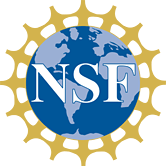
 The new base will be a 5,000-sq-m structure that can accommodate 64 people and 18 laboratories. As well as the living and working quarters, the company will build a heliport, solar panels and wind turbines that will power the base.
The new base will be a 5,000-sq-m structure that can accommodate 64 people and 18 laboratories. As well as the living and working quarters, the company will build a heliport, solar panels and wind turbines that will power the base. During that time I was able to visit with Rodney, the owner of Heritage Expeditions in Christchurch, New Zealand and Rowan Homes who owns Nautic Electronics.
During that time I was able to visit with Rodney, the owner of Heritage Expeditions in Christchurch, New Zealand and Rowan Homes who owns Nautic Electronics.

 The FT 897 problem was resolved with a bhi CAT-MATE Electronic “Y” Splitter and a quick jumper move at J102 on the ACC 1/8 inch socket for ALC and PTT control to the SPE amplifier.
The FT 897 problem was resolved with a bhi CAT-MATE Electronic “Y” Splitter and a quick jumper move at J102 on the ACC 1/8 inch socket for ALC and PTT control to the SPE amplifier.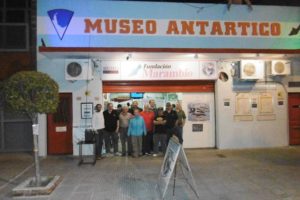 Following the Nov. 4th activation of the Antarctic Museum Marambio by the Radio CLUB QRM Belgrano hereby some datas coming from Raul Bobn Foster LU5AR, Secretary of the RC:- Se ha completado la información en la página de la actividad. Toda la información en general y el log en particular, está listo. Se hicieron más de 300 QSOs-.
Following the Nov. 4th activation of the Antarctic Museum Marambio by the Radio CLUB QRM Belgrano hereby some datas coming from Raul Bobn Foster LU5AR, Secretary of the RC:- Se ha completado la información en la página de la actividad. Toda la información en general y el log en particular, está listo. Se hicieron más de 300 QSOs-.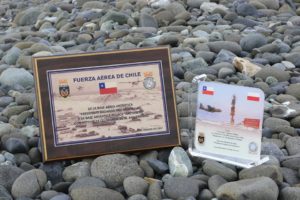 Now that the Antarctic Campaign 2017-2018 is almost open, it’s time to make presentations and get to know the neighbors.
Now that the Antarctic Campaign 2017-2018 is almost open, it’s time to make presentations and get to know the neighbors.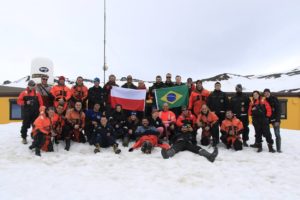
 Just to inform the readers, Antarctic lovers and followers that, it’s time to meditate about the 15th Antarctic Activity Week which will be on air from 17 through 25 Febr. 2018.
Just to inform the readers, Antarctic lovers and followers that, it’s time to meditate about the 15th Antarctic Activity Week which will be on air from 17 through 25 Febr. 2018.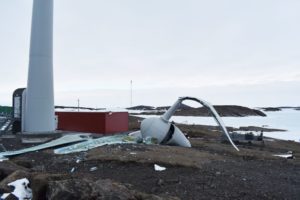 Part of a wind turbine at Australia’s Mawson research station (WAP AUS-Ø4) in Antarctica has collapsed overnight, no one was injured in the incident. The head of the turbine fell to the ground about 9 pm Mawson Station time last night.
Part of a wind turbine at Australia’s Mawson research station (WAP AUS-Ø4) in Antarctica has collapsed overnight, no one was injured in the incident. The head of the turbine fell to the ground about 9 pm Mawson Station time last night.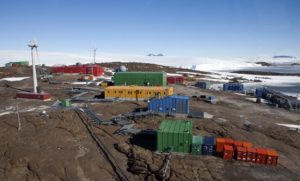 investigated.”
investigated.”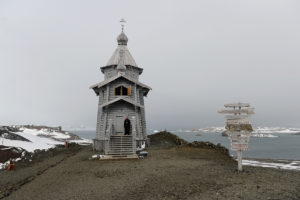 Members of the Antarctic Uruguayan ARTIGAS Base (WAP URY-Ø1), journalists and other guests visited the Trinity Church in Russia’s Bellinsghausen Polar Station (WAP RUS-Ø1) on King George Island, Antarctica, during the first week of December 2015. The priest explained to guest how the church was built as well as delivered a speech about the Orthodox and Christian churches in the twenty-first century. (see a video by cicking the gif aside)
Members of the Antarctic Uruguayan ARTIGAS Base (WAP URY-Ø1), journalists and other guests visited the Trinity Church in Russia’s Bellinsghausen Polar Station (WAP RUS-Ø1) on King George Island, Antarctica, during the first week of December 2015. The priest explained to guest how the church was built as well as delivered a speech about the Orthodox and Christian churches in the twenty-first century. (see a video by cicking the gif aside) 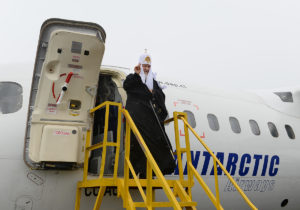
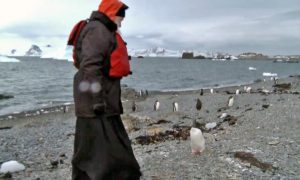
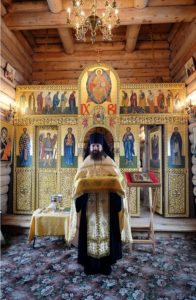

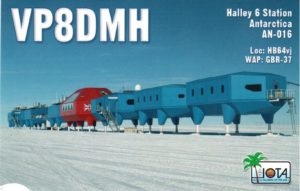 British Antarctic research station to shut for second winter as cracks in ice grow
British Antarctic research station to shut for second winter as cracks in ice grow  Novolazarevskaya Station is located at the extreme southeastern tip of the Schirmacher Oasis approximately in 80 km from the Lazarev Sea coast. An ice shelf with a slightly undulating surface resting against an ice cap extends north of the Station in the vicinity of Leningradsky Bay. From the south, there is a continental ice sheet slope. The station was opened on January 18, 1961. First constructions included service space, a living house, a mess-room and a power station, as well as glaciological, magnetic and actinometric pavilions and auxiliary space. There is a runway (1200 m x 60 m dimensions and the landing course of 114°) in the station area for ski- and wheeled aircraft located in 15 km south of the station on the ice sheet surface at the 500 m elevation above sea level.
Novolazarevskaya Station is located at the extreme southeastern tip of the Schirmacher Oasis approximately in 80 km from the Lazarev Sea coast. An ice shelf with a slightly undulating surface resting against an ice cap extends north of the Station in the vicinity of Leningradsky Bay. From the south, there is a continental ice sheet slope. The station was opened on January 18, 1961. First constructions included service space, a living house, a mess-room and a power station, as well as glaciological, magnetic and actinometric pavilions and auxiliary space. There is a runway (1200 m x 60 m dimensions and the landing course of 114°) in the station area for ski- and wheeled aircraft located in 15 km south of the station on the ice sheet surface at the 500 m elevation above sea level. If you check QRZ.com you will notice that R1ANL is reported to be a call being active from Leningradskaya Base; a good explanation is kindly given by Dominik Weiel DL5EBE (aka R3/DL5EBE).
If you check QRZ.com you will notice that R1ANL is reported to be a call being active from Leningradskaya Base; a good explanation is kindly given by Dominik Weiel DL5EBE (aka R3/DL5EBE). and I offered him to take care about the R1ANL QSL cards. A few months later I received the original handwritten R1ANL logs. I manually entered all QSOs into my computer and created ADIF files which I uploaded to LoTW, ClubLog and I also printed paper cards which are available via DL5EBE (buro and direct)-.
and I offered him to take care about the R1ANL QSL cards. A few months later I received the original handwritten R1ANL logs. I manually entered all QSOs into my computer and created ADIF files which I uploaded to LoTW, ClubLog and I also printed paper cards which are available via DL5EBE (buro and direct)-.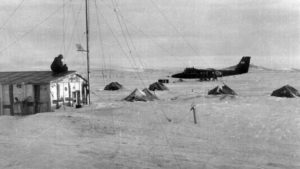 In 1969 the “Patrulla Soberania”, living in small tents, and with picks, shovels and much efforts, managed to give shape to the first airstrip in an Argentinean Antarctic Base. Thus was born the Marambio Base: gateway of large aircraft to the white continent.
In 1969 the “Patrulla Soberania”, living in small tents, and with picks, shovels and much efforts, managed to give shape to the first airstrip in an Argentinean Antarctic Base. Thus was born the Marambio Base: gateway of large aircraft to the white continent. Concordia Station (aka Dome “C” Station, WAP MNB-Ø3) is 1000 kilometers from the coast, 13 flight hours from New Zealand. The next inhabited place is the Russian Antarctic Station “Vostok” (WAQP RUS-13), 600 kilometers far away.
Concordia Station (aka Dome “C” Station, WAP MNB-Ø3) is 1000 kilometers from the coast, 13 flight hours from New Zealand. The next inhabited place is the Russian Antarctic Station “Vostok” (WAQP RUS-13), 600 kilometers far away. On the day of “The Night of Museums”, Hams of the “Radio Club QRM Belgrano” will be active as LU4AAO/D operating from the Marambio Antarctic Museum located in the town of Villa Adelina, Buenos Aires Province, next November 4th, 2017.
On the day of “The Night of Museums”, Hams of the “Radio Club QRM Belgrano” will be active as LU4AAO/D operating from the Marambio Antarctic Museum located in the town of Villa Adelina, Buenos Aires Province, next November 4th, 2017.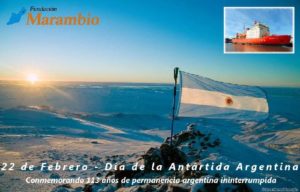 “Radio Club QRM Belgrano” has just add the entry of LU4AAO/D as WAP-286 on the activation page at:
“Radio Club QRM Belgrano” has just add the entry of LU4AAO/D as WAP-286 on the activation page at: 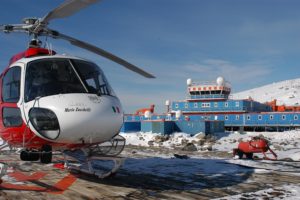
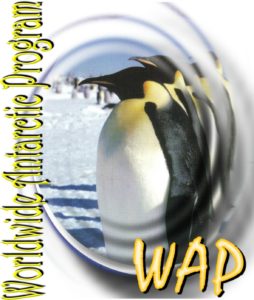 WAPonline is the only Antarctic site dedicated especially to the Hams worldwide, but also a way to increase the interest around Antarctic Continent and its related matters; to give students and chasers, the opportunity to share our passion, with the aim to stay close to the researchers and personnel who are spending their time away from home and families.
WAPonline is the only Antarctic site dedicated especially to the Hams worldwide, but also a way to increase the interest around Antarctic Continent and its related matters; to give students and chasers, the opportunity to share our passion, with the aim to stay close to the researchers and personnel who are spending their time away from home and families.
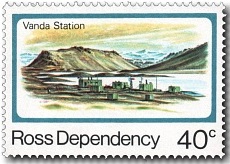 Vanda Station was an Antarctic Research Base in the western highlands (Victoria Land) of the Ross Dependency, specifically on the shore of Lake Vanda, at the mouth of Onyx River, in the Wright Valley. The four original station buildings were constructed in the summers of 1967–1968 and 1968–1969, just prior to the first winter-over by a five-man team from January to October 1969.
Vanda Station was an Antarctic Research Base in the western highlands (Victoria Land) of the Ross Dependency, specifically on the shore of Lake Vanda, at the mouth of Onyx River, in the Wright Valley. The four original station buildings were constructed in the summers of 1967–1968 and 1968–1969, just prior to the first winter-over by a five-man team from January to October 1969.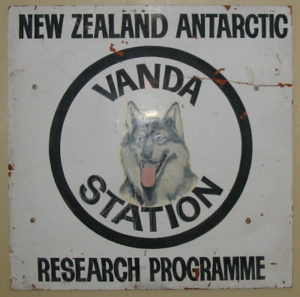
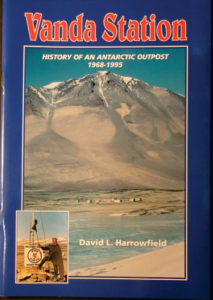 including excavations, the erection of buildings, disturbances caused by vehicle movements, the storage of consumables, waste disposal, and accidental spills, led to the effort to remove the station.
including excavations, the erection of buildings, disturbances caused by vehicle movements, the storage of consumables, waste disposal, and accidental spills, led to the effort to remove the station.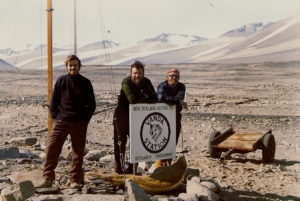
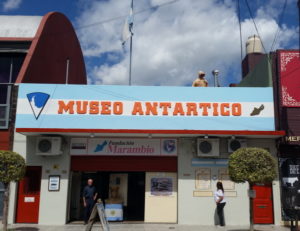 One of the most important Argentine Antarctic Museum did open its doors on the occasion of the Anniversary of Marambio Base foundation .
One of the most important Argentine Antarctic Museum did open its doors on the occasion of the Anniversary of Marambio Base foundation .